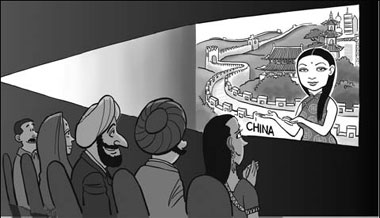Script for living happily ever after
By Debasish Roy Chowdhury (China Daily)
Updated: 2008-01-15 07:20
Updated: 2008-01-15 07:20
I had my Awara moment in Shanghai.
"Yindu?" asked the cheerful owner of the hole-in-the-wall restaurant I stumbled across after a heavy day of sightseeing. Reassured by my nod, he broke into a monologue, which, punctuated as it was with the word Yindu, I figured was something about India or Indians. And, judging by the approving looks of the other diners in the small room, nice things too. That happens to me all the time in China.

But then it came, slowly at first, then the beat picking up Abalagu, u uu, abalagu.
Seeing that I was not quite getting his point, he presented the final proof of his familiarity with India, the title song of Awara (The Tramp), a 1951 Hindi film that was a runaway hit in China when it released here later.
Not that I was taken aback. I had read Raj Kapoor, or La Zi, as the Chinese call him, is a household name in China, as he is in Russia and Romania. I had also heard the Chinese of a certain generation can all hum awara hoon (I am a vagabond), albeit they pronounce it differently. Still, the magic of that moment left an indelible spell on me, a first-hand proof of the soft power of a juggernaut called Bollywood.
India makes about 1,000 movies a year, nearly 10 times as many as Hollywood. A fifth of those are churned out by the Hindi film industry, or Bollywood, as some call it because the Hindi film industry is based in erstwhile Bombay, now renamed Mumbai. The rest are made in other regional languages.
The story of India and China is similar to the plot of a standard Bollywood flick: love, separation, reunion. And, crazy as it may sound, cinema may play a large role in making these two live happily ever after, la standard happy endings in Bollywood.
Allow me to justify my script.
The 1962 "war" has had a very different impact on the Chinese and the Indians. India's foreign policy toward China prior to the "war", as Indians know it, was defined by the slogan of "Hindi-Chini bhai bhai" (India and China are brothers), a policy on which the then Indian prime minister Jawaharlal Nehru had invested much of his geopolitical capital.
The reaction to the conflict was complete disappointment with China and everything Chinese, an impact manifested in Indian popular culture as well. Subsequent generations thus grew up on a staple of demonization of China and the Chinese in Hindi films.
This China phobia has marked much of India's politics ever since. So much so that when India conducted its nuclear test in 1998, the then Indian defense minister declared it was primarily because of China, as it was India's No 1 enemy. The same China phobia reared its head in sections of the Indian media recently when India's left parties threatened to block the US-India deal on nuclear power.
The general acceptability of such anti-China rhetoric is high in India because of the scar that the 1962 conflict left on the popular psyche and its perpetration through the most powerful popular medium, cinema.
The ordinary Chinese, on the other hand, barely know, or care, about 1962. Most Chinese are not even aware of the conflict. And the handful of those who are, know it as a border "skirmish", not "war", for which neither India nor China were responsible.
Instead, they have been taught to see it as a legacy of the machinations of imperial powers. India-bashing thus does not sell in China, nor are there any visible traces of it in its political or cultural spheres.
If the Chinese have anything for India, it is sheer fascination. The handful of Bollywood movies that landed in China since Awara and Do Bigha Zameen have been huge hits, sometimes bigger than in India itself. Caravan, a film of modest commercial success in India, ran to packed theaters in China in the 1980s, under the name of Da Peng Che.
Noorie, a movie about a village girl, also had a theater release here and did remarkably well. I know at least one Chinese who lost his teenage heart to Noorie: my night editor.

Bollywood movies slacked off a bit thereafter. It is not clear if it was because of the flagging interest in the song-and-dance routine or general apathy among Indian film distributors vis--vis China, or a combination of both, but the next big theater entrance for Bollywood took place as late as 2002 with Lagaan.
Chinese channels have screened Devdas and Asoka since, both drawing a lot of interest. Television soaps from India, namely Karishma and Koshish ek Asha, have a large fan following. Aishwarya Rai sets hearts aflutter with the same ease here as she does there. People pay big bucks to learn "Yindu" dance, or Bollywood-style gyrations. In short, Bollywood is the most successful Indian export to China though India has not even been selling it hard enough.
From all accounts, films do not figure in the agenda of bilateral talks during Manmohan Singh's trip. Sure, there are weightier things to discuss, like the thorny border issue for one. Then there is trade. What chance does cinema have against politics and money? None, apparently. But the fact is, China and India have a lot to gain on both counts from films.
China now allows 20 foreign films for theater release each year on a revenue-sharing basis, and most of these are from Hollywood. In a good year, an odd Bollywood film slips into this quota. That is a huge market lying virtually untapped.
India's film business grossed over $2 billion worldwide in 2006. According to a PricewaterhouseCoopers study, revenue will cross $4 billion over the next five years. But it is still a fraction of global cinema revenues. Prizing open the vast Chinese market will give Indian films the much-needed dollar muscle.
While India and China still have not realized the potential of joining these two mega markets, Hollywood has. That is why Warner Bros is making its first foray into Bollywood with a movie named Made in China.
It is about a Mumbai cook who is mistaken for a kungfu master, and will be the first Hindi-language film ever to be filmed in China, the third largest movie producer after Bollywood and Hollywood.
In return for allowing more Indian movies, China can directly push its own films into India, not through Hollywood, as it now does. This will open up a market of 1.3 billion people for Chinese films, and help Indians see the Chinese minus the prism of Hollywood.
But how in the world will cinema ease political tensions between the two countries? Once Indian filmmakers wake up to the potential of the Chinese market, they will incorporate Chinese tastes, faces and sensitivities in their movies, like Made in China.
A powerful vehicle of China phobia will thus have been converted into a stakeholder in Sino-Indian peace. Watching the same movies, the Chinese and the Indians will laugh together, cry together, fall in love together and, at some point, fall in love with each other. I will wager that no bilateral problem will look that insurmountable then.
One of the standard Bollywood themes down the years has been about brothers separated at birth, growing up in different circumstances and finally finding each other. Here is to the hope that the Hindi-Chini bhais will go to the same movie and rediscover each other some day.
The author is a senior editor at China Daily
(China Daily 01/15/2008 page9)
|
|
|
|